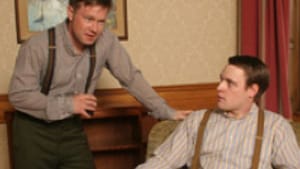Stay in the Loop
BSR publishes on a weekly schedule, with an email newsletter every Wednesday and Thursday morning. There’s no paywall, and subscribing is always free.
O'Neill's masterpiece:
A web without a spider
"Long Day's Journey' at Villanova

EgoPo gave Philadelphia audiences a substantial tour d’horizon of the work of Tennessee Williams last season, but who would undertake that for Eugene O’Neill, by a large stretch still our greatest playwright? O’Neill is talky (well, Irish after all); his plot structures often creak; his diction is rambling and dated; and his theatrical devices frequently hokey: Almost none of his plays, I think, would survive a modern playwrights’ workshop. And God bless him for these faults, for O’Neill is a great poet, and the most fearless searcher of hearts our stage has yet produced.
O’Neill’s great subject is the family, and it has been the subject of American theater— through Williams and Sam Shepard— ever since. This is a little strange when you think about it, because our literature, like much of our national experience, has so often been about lighting out for the territory— the unclaimed space where identity could be forged anew and forebears conveniently forgotten. But New England was always different: first colonized by the Puritans, and then, through O’Neill himself, by Freud.
O’Neill’s Irish Catholics aren’t Puritans, of course. Nevertheless, the Puritan strain runs through them, absorbed from the soil. The taint of original sin haunts them, and redemption lasts no longer than the last whiskey bottle.
Meet the Tyrones
The Tyrones, protagonists of O’Neill’s quasi-autobiographical Long Day’s Journey into Night, provide the case in point. James Tyrone Sr. (Daniel Kern) is a wealthy skinflint, an actor who traded in his talent for a lifetime sinecure in a single plum role and keeps his family on short rations. His elder son Jamie (Luke Moyer) is an embittered ne’er-do-well who has squandered his own talent and hides despair under alcoholic bluster; his younger one, Edmund (Matt Silva), is a fledgling poet who will discover, in the course of the single day’s action that constitutes the play, that he has consumption, and at best a compromised future.
Mary, wife and mother (Joanna Rotte), is a drug addict whose own day begins with a relapse, and who by nightfall will wind up in a private perdition as hellish as any a John Winthrop could imagine.
The play’s greatness lies in its slow revelation of character, and of the web of guilt, suffering and mutual hurt that ties its four principals helplessly together. It’s a web without a spider, for there is no pure villain in the play and no simple victim: All are implicated.
The elder Tyrone is aware that his miserliness is rooted in childhood deprivation, but, feeling powerless to change his behavior, he excuses himself for the damage it causes. Mary feels likewise powerless to resist her addiction, and so willingly succumbs to it despite the pleas of her husband and children. Jamie and Edmund find justification for their dependency in their parents’ behavior, and make no effort to liberate themselves. The result is an unwearied round of self-pitying recrimination that marks the journey into night.
Compassion beneath ferocity
What saves the play is compassion: not the sporadic compassion the characters offer each other, but the great compassion the playwright lends each and all of them. Even at their cruelest and most lacerating— and the Tyrones can go at each other with a ferocity that makes Who’s Afraid of Virginia Woolf? look like a children’s fairytale— their suffering is continually exposed, and their tormented love is never in doubt. It is this aspect that makes us willing to share their suffering rather than dismiss it, and to recognize in their weakness our own.
It’s doubly fitting that Villanova has opened its 50th season with Long Day’s Journey into Night, partly because of the play’s centrality to the American stage, and partly because Vasey Hall, Villanova’s stage for 40 years, was inaugurated with a production of the play in 1968. Robert Hedley, head of Temple’s playwriting program, directed the play then, and he does so now again. His cast is able, and sometimes more than that.
Masking his demons
Dan Kern’s James Tyrone was understatedly effective, and although there is more scope to his character than Kern allows to appear, he is particularly successful at conveying the superficial bonhomie with which Tyrone masks his demons. Mary is the character around which the others all pivot, and whose weakness tyrannizes them far more than any strength could. Joanna Rotte captured her deceitful cunning and final innocence in a richly nuanced portrait.
Luke Moyer’s Jamie was initially restrained, but in the great scene where he bares his hatred for Edmund, he took the play by the throat, and the production to another dimension: It was an eruption of pure force. Kristen O’Rourke, as the heavy-brogued serving girl Cathleen, stole scenes as easily as nips of James Tyrone’s whiskey.
Hedley’s direction let the play speak for itself, and, although the passage of time is one of its essential themes, none of it hung heavy on the audience. Only one touch seemed ill judged: when fog (a key metaphor in the text) was introduced onstage in the final scene. O’Neill needs no such burnishing. He knew, I think, that he had written his masterpiece, when he described it as “this play of old sorrow, written in tears and blood.” Blood it draws from its protagonists; and tears from us.
O’Neill’s great subject is the family, and it has been the subject of American theater— through Williams and Sam Shepard— ever since. This is a little strange when you think about it, because our literature, like much of our national experience, has so often been about lighting out for the territory— the unclaimed space where identity could be forged anew and forebears conveniently forgotten. But New England was always different: first colonized by the Puritans, and then, through O’Neill himself, by Freud.
O’Neill’s Irish Catholics aren’t Puritans, of course. Nevertheless, the Puritan strain runs through them, absorbed from the soil. The taint of original sin haunts them, and redemption lasts no longer than the last whiskey bottle.
Meet the Tyrones
The Tyrones, protagonists of O’Neill’s quasi-autobiographical Long Day’s Journey into Night, provide the case in point. James Tyrone Sr. (Daniel Kern) is a wealthy skinflint, an actor who traded in his talent for a lifetime sinecure in a single plum role and keeps his family on short rations. His elder son Jamie (Luke Moyer) is an embittered ne’er-do-well who has squandered his own talent and hides despair under alcoholic bluster; his younger one, Edmund (Matt Silva), is a fledgling poet who will discover, in the course of the single day’s action that constitutes the play, that he has consumption, and at best a compromised future.
Mary, wife and mother (Joanna Rotte), is a drug addict whose own day begins with a relapse, and who by nightfall will wind up in a private perdition as hellish as any a John Winthrop could imagine.
The play’s greatness lies in its slow revelation of character, and of the web of guilt, suffering and mutual hurt that ties its four principals helplessly together. It’s a web without a spider, for there is no pure villain in the play and no simple victim: All are implicated.
The elder Tyrone is aware that his miserliness is rooted in childhood deprivation, but, feeling powerless to change his behavior, he excuses himself for the damage it causes. Mary feels likewise powerless to resist her addiction, and so willingly succumbs to it despite the pleas of her husband and children. Jamie and Edmund find justification for their dependency in their parents’ behavior, and make no effort to liberate themselves. The result is an unwearied round of self-pitying recrimination that marks the journey into night.
Compassion beneath ferocity
What saves the play is compassion: not the sporadic compassion the characters offer each other, but the great compassion the playwright lends each and all of them. Even at their cruelest and most lacerating— and the Tyrones can go at each other with a ferocity that makes Who’s Afraid of Virginia Woolf? look like a children’s fairytale— their suffering is continually exposed, and their tormented love is never in doubt. It is this aspect that makes us willing to share their suffering rather than dismiss it, and to recognize in their weakness our own.
It’s doubly fitting that Villanova has opened its 50th season with Long Day’s Journey into Night, partly because of the play’s centrality to the American stage, and partly because Vasey Hall, Villanova’s stage for 40 years, was inaugurated with a production of the play in 1968. Robert Hedley, head of Temple’s playwriting program, directed the play then, and he does so now again. His cast is able, and sometimes more than that.
Masking his demons
Dan Kern’s James Tyrone was understatedly effective, and although there is more scope to his character than Kern allows to appear, he is particularly successful at conveying the superficial bonhomie with which Tyrone masks his demons. Mary is the character around which the others all pivot, and whose weakness tyrannizes them far more than any strength could. Joanna Rotte captured her deceitful cunning and final innocence in a richly nuanced portrait.
Luke Moyer’s Jamie was initially restrained, but in the great scene where he bares his hatred for Edmund, he took the play by the throat, and the production to another dimension: It was an eruption of pure force. Kristen O’Rourke, as the heavy-brogued serving girl Cathleen, stole scenes as easily as nips of James Tyrone’s whiskey.
Hedley’s direction let the play speak for itself, and, although the passage of time is one of its essential themes, none of it hung heavy on the audience. Only one touch seemed ill judged: when fog (a key metaphor in the text) was introduced onstage in the final scene. O’Neill needs no such burnishing. He knew, I think, that he had written his masterpiece, when he described it as “this play of old sorrow, written in tears and blood.” Blood it draws from its protagonists; and tears from us.
Sign up for our newsletter
All of the week's new articles, all in one place. Sign up for the free weekly BSR newsletters, and don't miss a conversation.

 Robert Zaller
Robert Zaller